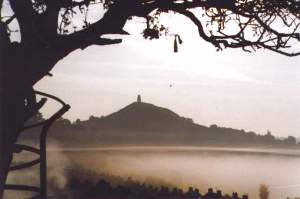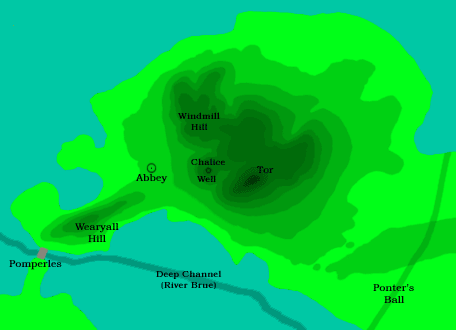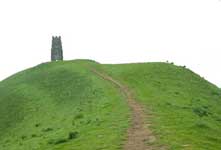Glastonbury History
Glastonbury, a small town in Somerset, is surrounded by a grouping of hills. The tallest of these hills is known as the Tor, which happens to have an old stone tower on the very top which was once a church dedicated to the archangel Michael. Close to the Tor is Chalice Hill. Wearyall Hill is a long, narrow ridge that points towards Bristol Channel. Finally, there's Windmill Hill which faces the cathedral city of Wells and just below are the ruins of the medieval abbey. Before the land was drained for farmland in later Christian times, the hills around Glastonbury appeared as islands from the West. Today's river Brue (the dark blue line at the bottom of the map) was once the deepest channel in the shallow swamps and allowed boats to pass. The ancient name for the Tor was Ynys Witrin, which means 'the Island of Glass.' But this 'island' is more widely known from Celtic lore as Avalon, the Apple-place and the isle of enchantment.  The ancient Celtic name for the Tor was Ynys Witrin, 'Island of Glass.' Another Celtic name was Caer Wydyr, 'Fort of Glass,' which is also the third name for the Celtic Otherworld. Surrounded mostly by water, a defensive wall known as Ponter's Ball was erected to the East and protected Glastonbury from the mainland. A bridge, known as the Pomparles or as Perilous Bridge, was the only dry access point to the south. Pomparles is thought to be the place where Bedwyr, from the Arthurian legend, returned the sword Excalibur to the Lady Of The Lake after the Battle of Camlann. In Celtic legends, Avalon was the Otherworld home of the underworld god, Afallach. Both the names Avalon and Afallach refer to apples, apples that once grew in Glastonbury. Being a Otherworld sacred site, Glastonbury would be the site where a Celtic king would be sent when near or at death. Such was the case of King Arthur when he was sent to Avalon after his final battle. 
Glastonbury, held sacred long before Christianity, was settled by the Celts and the area was used for religious ceremonies and as a trade route/port. A long trailing terrace winds its way around the sides of the Tor. Though weathered and eroded over time, the trail, its true purpose unknown, has been associated with similiar devices or patterns from other cultures. Scholars believe it may have been built about the same time as the structures at Stonehenge and Avebury. No other structures from this period were found except for a pre-historic Earthwork construct known as Ponter's Ball. Ponter's Ball runs across the high ground about two miles East of Glastonbury. The running mound is thought to be a wall marking the boundary of the sacred Glastonbury precinct. From both ancient and current times, the Tor has also been a sanctuary of Goddess worship. Goddess worship can be found in the Celtic and Arthurian legends; the Lady Vivien, a Celtic water goddess and also known as the Lady Of The Lake. As a sacred territory, a federal assembly of twelve tribes upheld the local law. Known as the Twelve Hides of Glaston, divine law was administered by priestly rulers. King Arviragus, a pagan ruler in 63CE, was the first to grant Twelve Hides, or 120 acres of land, upon twelve early christian missionaries led by Joseph of Arimathea. Though no record exists it is believed that granting of the Twelve Hides was a tradition from an earlier time when Glastonbury was a Druid sanctuary. No authority outside the Twelve Hides could administer in Glastonbury. Interestingly, the rights of the Twelve Hides were recognized by later Saxon and Norman kings. Each new successive king solidified the rights of the Twelve Hides which binded the successor to recongize their authority. 
Centuries later, after the break from the Roman Empire, a group of Celtic monks took up quarters beside Glastonbury's small wattle church. Under the Celtic monks, the site of the ancient church became known as "the holiest Earth of England" and was recongized as the place where christian faith was first planted in England. Today, the Lady Chapel among the abbey ruins marks the location of the ancient church. When christianity in Glastonbury began, most of the inhabitants were Celts. Later, pagan Anglo-Saxons moved in from across the North Sea and gradually overran the country. Upon their arrival, the Anglo-Saxons destroyed all christian institutions. The only threat to Glastonbury was the West Saxon kingdom but by the time it reached Glastonbury, in about 650CE, the West Saxon king was christian. Only in Glastonbury was there an unbroken line of christian worship in England. The ancient church was not only spared but was expanded. The monastery grew into an abbey of the Benedictine Order in 673CE. It was under the abbot St. Dunstan that the surroundings swamps were drained and the river was dyked, starting in 920CE. St. Dunstan also restored learning and religion in England after the destruction wrought by the Norse on the monasteries and monastic schools. Successors continued to drain the swamps and reclaim more land all the way to Bristol Channel by building sea walls. The monastery attracted much royal patronage, fame, and had accumulated great wealth in land, gold, religious relics and books. In 1184 CE, the ancient church, also known affectionately as the 'Old Church,' was destroyed in a fire. The Abbey was reconstructed by King Henry II but his death in 1189CE dropped royal patronage (his successor, King Richard I, was not interested.)In 1191CE while digging on the abbey grounds, the monks of Glastonbury made a fantastic discovery. Thanks to a tale from a Welsh bard, the monks began to dig on a specific area on the abbey grounds. The first thing discovered was a stone slab under which was found a large lead cross with an inscription in Latin, 'Here lies buried the renowned King Arthur in the Isle of Avalon.' Digging deeper, the monks found a coffin made from a hollowed out log. Inside the coffin were found the bones of a tall man. Also found were smaller bones of another person that the monks assumed to be Queen Guinever's. Due to the timing of the find by the monks (the fire and loss of patronage), most historians do not believe that the grave the monks found was that of King Arthur. In 1409CE, religious squabbling over religious entitlement led the bishop Robert Hallum of Salisbury to claim that England was of equal status to Italy, France and Germany thanks to the legends left by Joseph of Arimathea. This resulted in greater power and pantronage for the Abbey. The end of Glastonbury Abbey came in 1539CE when King Henry VIII had the abbey burned, took the Twelve Hides for himself and had the abbot hanged at the Tor. The king also had the body of the abbot dismembered and put on exhibition around the country. Today the abbey lies in ruins but the legends live on strong with the tell-tale reminders of the Glastonbury Thorn, the abbey ruins, the supposed marked grave site of King Arthur, Chalice Well with its red tinged water and the Tor. Religions and groups continue to make their appearance at Glastonbury; new age beliefs, christian, Arthurian legend seekers, and the old Celtic gods and goddess. But above it all is the simple beauty of the landscape. For more information check these great resources:
|